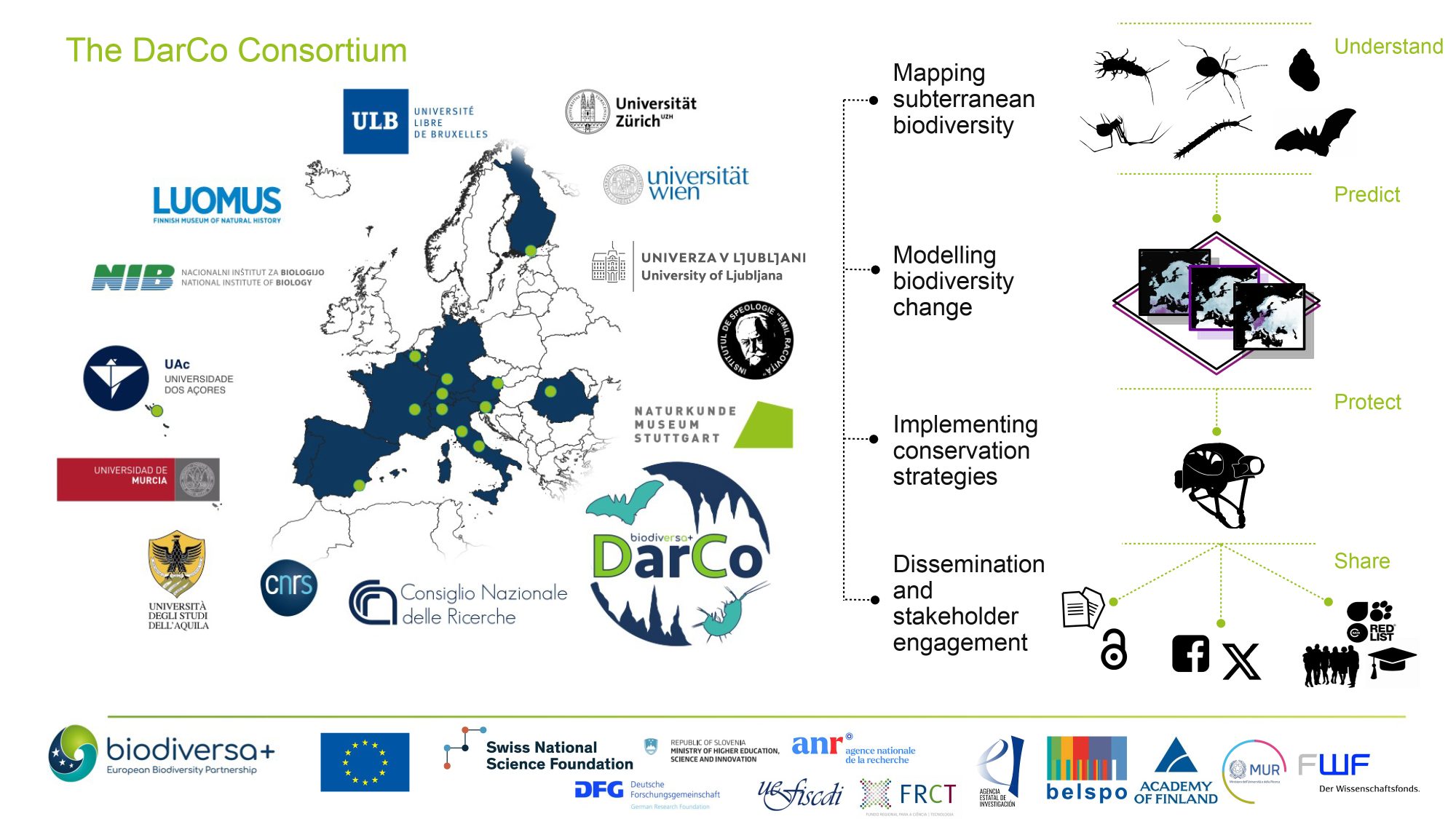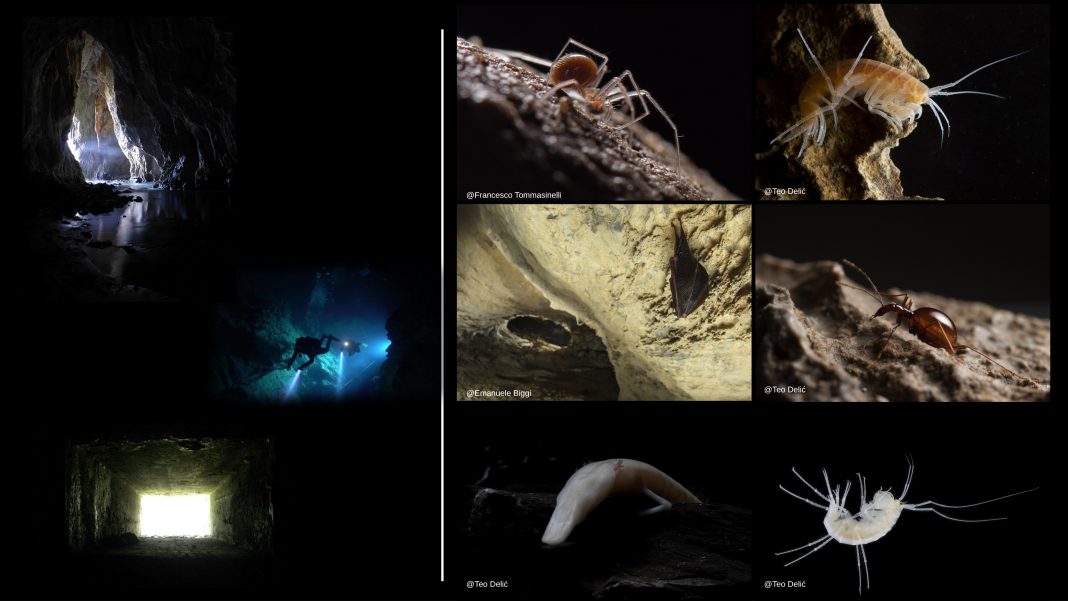Stefano Mammola, a researcher at the Italian National Research Council and coordinator of the Biodiversa+ project ‘DarCo’, emphasizes the importance of better incorporation of subterranean biodiversity in conservation agendas
Beneath our feet lies a vast and intricate network of caves, aquifers, fissures, and other voids teeming with unique life forms crucial to both human life and the environment. Groundwaters, for instance, represent the largest unfrozen freshwater reserve, serving as the primary water source for over half of the world’s population. Despite their importance, subterranean ecosystems receive minimal attention in current biodiversity and climate change agendas – a concerning oversight that demands urgent action. (1)
A rich and unique biodiversity in the dark
Estimates suggest there are upwards of 100,000 obligate subterranean animal species worldwide. These species range from micrometre-long crustaceans to 30cm-long cave salamanders, from eerie spiders spinning ephemeral webs to massive centipedes hunting prey in the dark. We have long begun documenting this biodiversity, with new species being discovered daily. These species are often endemic to just a few caves or aquifers and are found nowhere else. They exhibit unique adaptations to life in darkness: they lose their eyes and skin color, become better at finding food and mates using other senses, live longer, and can survive without food for extended periods. Additionally, countless species rely on subterranean ecosystems for part of their life cycle. For example, caves serve as daily and seasonal shelters for numerous bats, crickets, and butterflies, which are all fundamental components of interconnected subterranean-surface food webs. These connections highlight the importance of subterranean ecosystems for broader biodiversity and ecosystem health.

Biodiversity in peril
Subterranean ecosystems are facing increasing threats from human activities at the surface, such as land-use change (e.g., deforestation, urbanization, agriculture, pasture, industry) and climate change. These activities alter subterranean climatic conditions and cause various forms of physical and chemical pollution. Additionally, human activities can directly lead to subterranean habitat loss and degradation through infrastructure development (e.g., tunnel drilling, hydro-engineering, touristic facilities in show caves), extraction of rocky materials (e.g., opencast mining, quarrying), and groundwater abduction. This combination of indirect and direct impacts exerts significant pressure on subterranean ecosystems. (2)
Protecting subterranean ecosystems: it is not just about water quality
The European Union (EU) has enacted legislation to protect subterranean resources, such as by incorporating groundwaters in various water-related regulations (e.g., the Groundwater Directive [2006/118/EC], the Water Framework Directive [2000/60/EC], the Environmental Quality Standards Directive [2008/105/EC]) and by including a few charismatic subterranean species and habitats in the Habitats Directive (92/43/EEC). However, progress has been slow and fragmented, predominantly focusing on setting chemical thresholds for water quality while overlooking ecosystem processes. (2)
The quality and functioning of subterranean ecosystems are heavily dependent on the organisms that inhabit them, which provide critical services – e.g., filtration and purification of groundwater. Moreover, healthy surface ecosystems are closely connected to the state of subterranean ecosystems and vice versa. Therefore, it is crucial to adopt a broader perspective that includes protecting the entire surface-subterranean continuum, thereby maintaining ecosystem processes. (3)
The DarCo project
Implementing an ecosystem-oriented perspective in protecting subterranean ecosystems is at the core of DarCo, a project funded by the European Biodiversity Partnership under the 2021–2022 BiodivProtect joint call for research proposals, co-funded by the European Commission and supported by numerous national funding organizations. DarCo is led by a multidisciplinary consortium of scientists specializing in subterranean biology, macroecology, and conservation science from 13 EU research institutions across 11 countries.
A change in perspective to recognize out-of-sight subterranean systems
Two major obstacles impede the protection of subterranean ecosystems. First, there is a scientific challenge: subterranean biodiversity patterns remain largely unmapped, even in regions with a long history of speleological research, such as Europe. Second, there is a societal issue:
many people are unaware of the importance of these ecosystems for the environment and human health. Within DarCo, we aim to address both challenges. We are compiling all available data to map subterranean biodiversity and predict its change. Additionally, we are fostering dialogue with stakeholders interested in subterranean resources, including water management authorities, speleological groups, and decision-makers at various levels. Sharing credible, legitimate, and relevant information among researchers and stakeholders is crucial for successfully transferring scientific and technical knowledge into decision-making processes and the implementation of subterranean-oriented protected areas. (2)
Combining these efforts is essential to establish the scientific foundation for a strategic plan that better integrates subterranean ecosystems into the EU Biodiversity Strategy for 2030 and beyond. Contact the DarCo team to support these initiatives.
References
- Sánchez-Fernández, D. et al. (2021). Don’t forget subterranean ecosystems in climate change agendas. Nature Climate Change, 11(6), 458-459.
- Mammola, S. et al. (2024). Perspectives and pitfalls in preserving subterranean biodiversity through protected areas. npj Biodiversity, 3(1), 2.
- Saccò, M. et al. (2024). Groundwater is a hidden global keystone ecosystem. Global Change Biology, 30(1), e17066.
Project:
Project ‘DarCo’ (biodiversa+ 2021 – 2022 BiodivProtect)
Funder:
Biodiversa+ (project ‘DarCo’), the European Biodiversity Partnership under the 2021–2022 BiodivProtect joint call for research proposals, co-funded by the European Commission (GA N°101052342) and with the funding organizations Ministry of Universities and Research (Italy), Agencia Estatal de Investigación— Fundación Biodiversidad (Spain), Fundo Regional para a Ciência e Tecnologia (Portugal), Suomen Akatemia— Ministry of the Environment (Finland), Belgian Science Policy Office (Belgium), Agence Nationale de la Recherche (France), Deutsche Forschungsgemeinschaft e.V. (Germany), Schweizerischer Nationalfonds (Grant No. 31BD30_209583, Switzerland), Fonds zur Förderung der Wissenschaftlichen Forschung (Austria), Ministry of Higher Education, Science and Innovation (Slovenia), and the Executive Agency for Higher Education, Research, Development and Innovation Funding (Romania)
Project webpage:
http://www.meg.irsa.cnr.it/index.php/component/content/article?id=105

This work is licensed under Creative Commons Attribution-NonCommercial-NoDerivatives 4.0 International.


